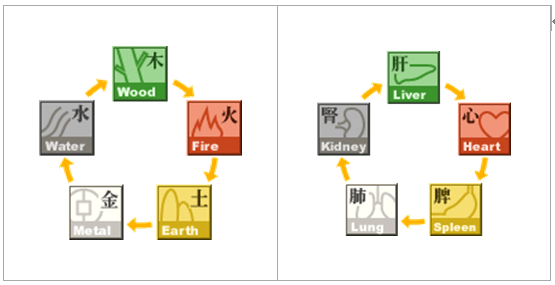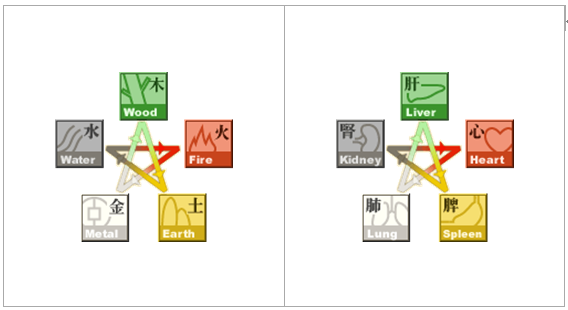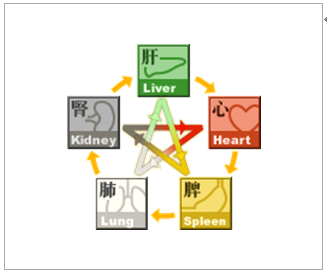What is the Five Elements Theory
Based on observations of the natural world, ancient Chinese people recognized continuous patterns of transformation and change in the universe. Initially, these observations were interpreted using yin yang logic, but later these interpretations were expanded using a new theory called the five elements.
The five elements theory evolved from the study of various processes, functions, and phenomena of nature. The theory asserts substances can be divided into one of five basic elements: wood, fire, water, metal and earth, which contain their own specific characteristics and properties. Today, the five elements theory is still used as a tool for grouping objects, and as a method for analyzing changes of natural phenomena.
The Origin of the Five Elements Theory
The yin yang theory has a close relationship with the five elements theory. They are often used simultaneously to explain natural phenomena. Ancient Chinese medical philosophers integrated the yin yang and five elements theories into their medical practices as early as the Warring States Period (475-221BC). As integration of these theories took place, a more formalized system of medicine was established. Today we refer to this medical system as Traditional Chinese Medicine (TCM).
The Five Elements and their Relationships with Nature and the Body
The five elements correspond to different aspects of the natural world and the body. Wood, for example, corresponds to spring and wind in the natural world and to the liver, gall bladder, eyes and tendons in the body. (See below table for a summary of these relationships)
|
As shown in the above table, there are organized relationships between the elements, nature and the body. The different vertical characteristics belong to the same element, and horizontally, each characteristic interacts with another according to a specific order and element. Working within this system of thought, everything has a correlation in nature.
The Relationship between the Five Elements
The five elements of wood, fire, earth, metal, and water are not isolated; rather they work closely together and have their own internal orders and patterns. The rules that govern the five elements include a mutual generation cycle, a mutual restriction cycle, over restriction, reverse restriction and balance between generation and restriction.
- Mutual Generation Cycle
This cycle refers to the manner in which the elements create one another. Wood easily burns and makes a fire. Fire produces ash, creating earth. The earth contains mineral from which metal is mined and extracted. When metal is heated and cooled, water droplets will be found over the metal as a result of condensation. Thus, metal creates water. Water promotes the growth of trees, which are wood. The cycle is cyclic and continually gives rise to change and transformation. (See figure 1. and figure 2.)
| Figure 1. This cycle shows how the five elements produce one another |
Figure 2. This cycle shows how the five organs promote one another |
| Index: |
|
The Chinese word “sheng” for “generate” incorporates several other meanings such as create, promote, nurture, support and enhance. The “generation” of the five elements in nature can also be applied to the body. This relationship is sometimes referred to as a mother-child relationship because only a mother can give birth to a baby. For example, fire is the mother of earth since fire creates earth. Correspondingly in the body, the heart (which has a fire element) is the mother of the spleen (earth element) because the heart supports and promotes spleen function. If heart function is deficient, the spleen will be affected. According to TCM thinking, a heart deficiency cannot sufficiently rule the blood. Therefore, the spleen cannot perform its normal transformation of qi and blood and disharmony results. This disharmony may be mild, but in severe cases, it can lead to disease.
- Mutual Restriction Cycle
This cycle refers to the manner in which the elements restrict and control one another. Wood breaks up the soil and depletes the earth’s nutrients, thus controlling earth. Earth contains water in many places, and as dam prevents flooding, earth controls water. Water extinguishes fire, and therefore, controls its spread. Fire controls metal by its ability to melt it. Metal can be made into an axe that cuts wood into pieces, thus controlling wood. The control repeats in a cyclic fashion and provides an opposite force to balance the generative power. The generation and restriction properties of the five elements hold each other in check, preventing over-functioning. (See figure 3. and figure 4.)
| Figure 3. This cycle shows how the five elements restrict one another |
Figure 4. This cycle shows how the fiveorgans restrict one another |
| Index: |
|
- Over-Restriction
The Chinese word for restriction, “ke” means “inhibition” or “winning over”. In nature, wood controls the earth. (See figure 3.) In the body, the liver (a wood element) controls the spleen (an earth element) and inhibits its functions in a balanced manner. If the liver’s function becomes excessive, there will be over-restriction of spleen function causing an imbalance in the body. This happens because excessive liver function produces fire, which in turns affects the smooth flow of qi. Without good qi flow to start, the spleen cannot successfully transform food into more qi.
- Reverse-Restriction
If the enemy is too strong, the controlling element itself becomes controlled in a reverse manner (i.e. the original restriction is insufficient). When wood is too strong and its controlling metal axe is too blunt, the axe cannot cut the wood and may even break as a result of the rebound force if an attempt is made to chop it. This illustrates reverse restriction because the wood is able to restrict metal, which is not usually the case. In our body, if the spleen functions excessively, its controlling liver will also be restricted in a reverse manner. The excessive spleen function will produce heat and dampness, which doesn’t have a sufficient release in the body. The constrained damp heat will heat up the liver and the gall bladder. When this occurs, the gall bladder can no longer properly regulate bile secretion, and disease occurs.
- Balance between Generation and Restriction
A famous TCM physician Zhang JingYue (1563-1640 AD) said, “The mechanism of creation cannot do without promotion. Neither can it do without control. If there is no promotion, there will be no development and growth. If there is no control, the unbalanced excitement will be harmful. It is necessary to have control inside promotion and to have promotion inside control, so that everything can operate continuously, in both a complementary and opposite manner.”
Balance between generation and restriction is important for normal transformation of the five elements. Each element is under the influence of the other four in some way. Wood generates fire and water generates wood. On the other hand, wood inhibits earth, but itself is inhibited by metal. In this way, all five elements establish an intricate homeostasis in nature. This wisdom has also been applied to TCM by incorporating the theory of the five elements into health maintenance strategies, which have been successful for thousands of years. (See figure 5.)
Figure 5.
Combined generation & restriction cycle
Index: ![]() Generates
Generates
Index: ![]() restricts
restricts
Correlations within the Five Elements
Phenomena in the natural world are grouped into one of the five elements according to their properties, functions and appearance, but other correlations can be made among them. By using wood as an example, we can illustrate its many relationships with nature and the body. In spring, wood is in season, and the climate is warm and windy. Young grass and trees start to germinate and grow. A green colour covers the grasslands and forests forming a refreshing picture. Spring, wind, germination and the colour green all belong to the wood element and relate to each other in a synergistic way.
In the body, the liver, which is also part of the wood element, is responsible for spreading and ensuring the smooth flow of qi like the wind spreads around air. In Chinese terms, the function is described as “sprinkling”. Similar to germinating grass, the liver needs to be soft, light and gentle for a desirable healthy state. In addition, the liver is also physiologically and functionally related to the eyes and gall bladder. We can understand their connections better with the example of jaundice. People who have jaundice caused by gall bladder obstruction or liver malfunction will have yellow eyes.
Diagnostic and Therapeutic Applications of Selected Organs
- Kidneys
The kidneys belong to the water element. Just as water supports the growth and development of plants, the kidneys support the birth, development and maturation of humans. Storage of “jing” is the main function of the kidneys. “Jing” is a substance essential for reproduction, development and maturation, and additionally it provides vitality for performing daily life activities. Therefore, in TCM the kidneys are known as the root of life.
Being from the water element, the kidneys also control water, so disharmony of water in the body can also be a sign of kidney disharmony. For example, urinary incontinence (the inability to control proper urination) indicates a kidney deficiency. Hearing disorders or even deafness can also occur in elderly people who are kidney deficient. This is because the kidneys are connected with the ears, which belong to the water element under the orifice classification.
Colour is another indication of kidney disharmony. Renal (kidney) failure patients often have a darker skin complexion than their normal colouring. From a western medicine perspective, this is due to the kidneys being unable to excrete uremic toxins that build up in the blood and body. Since ancient times, TCM practitioners have also been able to diagnose renal failure because they associated the “blackening” of the skin with kidney disharmony. This is due to the fact both the colour black and the kidneys are grouped under the water element. Another example of this type of correlation is the emotion of fear. A person who is fearful in a particular situation may experience urinary incontinence. Again, the relationship of fear to the kidneys and bladder under the water element is what causes urinary incontinence to occur and not something else.
- Liver
As previously mentioned, the liver belongs to the wood element and controls the flow of qi. If a person has angry emotions, the liver will be adversely affected and liver disharmony can manifest as a shady green colour on the face. Since the liver is connected to the eyes, some types of dizziness and eye disorders are related to liver dysfunction from a TCM point of view. By restoring normal liver function, the eye problem will automatically be cured.
How Generation and Restriction Works
(The story of a clever doctor)
There once was a newly elected mayor who came to a village to help the people. Being new, he met many challenges in governing the village and was overwhelmed by his tasks. Soon, he experienced profound pensiveness and felt very sick. One day, he invited a renowned village doctor to his house to help cure him. The doctor felt his pulse and then thought for a while. Suddenly, he had a crazy idea and said, “Congratulations, mayor! Your symptoms are signs of pregnancy. Don’t worry too much. You will get better soon.” No sooner had the doctor spoken, the mayor shouted angrily, “Get out! I am male. How can I be pregnant? How ridiculous you are!” A short time later, the mayor’s illness disappeared, just as the doctor had predicted.
How was the mayor cured? The answer lies in the generation and restriction abilities of the five elements. According to TCM, the mayor’s sickness belonged to earth disharmony, because pensiveness is part of the element earth. Excessive pensiveness harms the spleen, which is also part of the element earth, but wood restricts earth. While anger is the emotion of liver and wood element, sudden and excessive anger can easily inhibit the excessive earth. Therefore, the renowned doctor deliberately made the mayor angry and effectively neutralized his pensiveness. By controlling the mayor’s excessive earth element, his body’s harmony was restored and he was cured.
The Five Elements and a Healthy Lifestyle
The relationships of the five elements play an important role in maintaining a balanced lifestyle. This is illustrated in season changes. During the spring season, which belongs to the wood element, we should avoid excessive anger in order to stay healthy. In the winter season, which belongs to the water element, our bodies prefer to store energy so rest is important. Storage is an important function of the water element; therefore, in winter it is advisable for people to go to bed early. Even today, the application of the five elements theory remains relevant in promoting health. Understanding the relationships between the elements is the first step to achieve a harmonious balance in nature and life.




